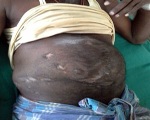
Greenish sputum (Bilioptysis) An enigma in Gastroenterology
Abstract
Broncho-biliary fistula (BBF) is a communication between the biliary system and the bronchial tree. It manifests as bilioptysis (coughing of bile). It is quite rare but a serious complication. There are many hepatobiliary conditions leading to the development of BBF. The most common is drainage of intra-hepatic abscess subsequently leading to fistula formation between the biliary tree and pulmonary tree. It most commonly presents with chronic cough and production of greenish sputum. It can rarely present as acute pneumonitis. The mechanism of fistula formation is not clear, but is believed that local inflammatory process lead to false communication between the biliary tree and bronchi. There are various modalities to demonstrate BBF, but the most definitive methods are PTC, HIDA and ERCP. Here we report 2 cases of BBF, one due to hepatic abscess and the other due to PTBD for CBD obstruction secondary to inoperable hilar cholangiocarcinoma. BBF was demonstrated by HIDA in the first patient and the other patient by ERCP. Both patients were treated with ERCP and biliary stenting. They had gradual resolution of bilioptysis.
Full Text:
PDFReferences
Peacock TB. Case in which hydatids were expectorated and one of suppuration of hydatid cyst of the liver communicating with the lungs. Edinburgh Med J 1850; 74: 33-46
D.M. Rose, A.T. Rose, W.C. Chapman, et al.Management of bronchobiliary fistula as a late complication of hepatic resection. Am Surg, 64 (1998), pp. 873–876
Weis.S, Mössner J, Schoppmeyer K. A 79-year-old patient with yellow sputum. Gastroenterology 2010; 138: e1-e2
Aydin U, Yazici P, Tekin F, Ozutemiz O, Coker A. Minimally invasive treatment of patients with bronchobiliary fistula: a case series. J Med Case Reports 2009; 3: 23
Gandhi N, Kent T, Kaban JM, Stone M, Teperman S, Simon R. Bronchobiliary fistula after penetrating thoracoabdominal trauma: case report and literature review. J Trauma 2009; 67:E143-E145
Yoon DH, Shim JH, Lee WJ, Kim PN, Shin JH, Kim KM. Percutaneous management of a bronchobiliary fistula after radiofrequency ablation in a patient with hepatocellular carcinoma.Korean J Radiol 2009; 10: 411-415
Morton JJ, Phillips EW. Bronchobiliary fistula; a review of the recorded cases other than those due to echinococcus and amebic disease. Arch Surg 1928; 16:697-753.
Katsinelos P, Paroutoglou G, Chatzimavroudis G, Beltsis A, Mimidis K, Katsinelos T, Pilpilidis I,Papaziogas B. Successful treatment of intractable bronchobiliary fistula using long-term biliary stenting. Surg Laparosc Endosc
Bhasin DK, Rana SS, Rawal P, Gupta R, Wig JD, Nagi B, Singh K. Successful resolution of bronchobiliary and biliocutaneous fistula by prolonged endoscopic transpapillary biliary drainage.Indian J Gastroenterol 2008; 27: 207-209 Guan-Qun Liao, Hao Wang, Guang-Yong Zhu, Kai-Bin Zhu, Fu-Xin Lv, Sheng Tai. Management of acquired bronchobiliary fistula:
A systematic literature review of 68 cases published in 30 years.
World J Gastroenterol 2011 September 7; 17(33): 3842-3849.
Schwartz ML, Coyle MJ, Aldrete JS, Keller FS. Bronchobiliary fistula: complete percutaneous treatment with biliary drainage and stricture dilation. Radiology 1988; 168: 751-752
D’Altorio RA, McAllister JD, Sestric GB, et al. Hepatopulmonary fistula: treatment with biliary metallic endoprosthesis. Am J Gastroenterol 1992;87:784-65.
Refbacks
- There are currently no refbacks.

This work is licensed under a Creative Commons Attribution-NoDerivatives 4.0 International License.
An initiative of The Tamil Nadu Dr M.G.R. Medical University